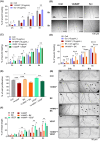14K prolactin derived 14-mer antiangiogenic peptide targets bradykinin-/nitric oxide-cGMP-dependent angiogenesis
- PMID: 39312470
- PMCID: PMC11609586
- DOI: 10.1002/2211-5463.13895
14K prolactin derived 14-mer antiangiogenic peptide targets bradykinin-/nitric oxide-cGMP-dependent angiogenesis
Abstract
Over the past few decades, VEGF-targeted antiangiogenic therapy for cancers has gained increasing attention. Nevertheless, there are still several limitations such as the potential resistance mechanisms arising in cancer cells against these therapies and their potential adverse effects. These limitations highlight the need for novel anti-angiogenesis molecules and better understanding of the mechanisms of tumor angiogenesis. In the present study, we investigated the antiangiogenic properties of a novel 14-mer antiangiogenic peptide (14-MAP) derived from N-terminal 14 kDa buffalo prolactin and characterized its mode of action. 14-MAP at the picomolar concentration inhibited VEGF- and bradykinin (an autacoid peptide expressed in vascular tissues in pathophysiology, BK)-stimulated endothelial nitric oxide (eNO) production, cell migration, and proliferation in endothelial cells and vessel development in the chick embryo. Although this peptide inhibited both VEGF- and BK-dependent angiogenic processes, its action was more pronounced in the latter. Moreover, the interference of 14-MAP with the eNO synthase (eNOS)-cyclic GMP pathway was also identified. A combination of a low dose of Avastin, a widely used drug targeting VEGF-dependent angiogenesis, and 14-MAP significantly reduced tumor size in an in vivo model of human colon cancer. Taken together, our results suggest that 14-MAP, a BK- and eNOS-dependent antiangiogenic peptide, might be useful for overcoming the limitation of VEGF-targeted antiangiogenic therapy in cancer patients. However, further studies will be required to further characterize its mode of action and therapeutic potential.
Keywords: antiangiogenic peptide; anti‐angiogenesis; bradykinin; endothelial nitric oxide synthase; prolactin.
© 2024 The Author(s). FEBS Open Bio published by John Wiley & Sons Ltd on behalf of Federation of European Biochemical Societies.
Conflict of interest statement
The authors declare no conflict of interest.
Figures




Similar articles
-
Endothelium-derived nitric oxide (NO) activates the NO-epidermal growth factor receptor-mediated signaling pathway in bradykinin-stimulated angiogenesis.Arch Biochem Biophys. 2014 Sep 15;558:14-27. doi: 10.1016/j.abb.2014.06.011. Epub 2014 Jun 21. Arch Biochem Biophys. 2014. PMID: 24960080
-
16K-prolactin inhibits activation of endothelial nitric oxide synthase, intracellular calcium mobilization, and endothelium-dependent vasorelaxation.Endocrinology. 2004 Dec;145(12):5714-22. doi: 10.1210/en.2004-0647. Epub 2004 Sep 9. Endocrinology. 2004. PMID: 15358675
-
Antiangiogenic mechanisms of PJ-8, a novel inhibitor of vascular endothelial growth factor receptor signaling.Carcinogenesis. 2012 May;33(5):1022-30. doi: 10.1093/carcin/bgs127. Epub 2012 Mar 20. Carcinogenesis. 2012. PMID: 22436611
-
Targeting Angiogenesis in Cancer Therapy: Moving Beyond Vascular Endothelial Growth Factor.Oncologist. 2015 Jun;20(6):660-73. doi: 10.1634/theoncologist.2014-0465. Epub 2015 May 22. Oncologist. 2015. PMID: 26001391 Free PMC article. Review.
-
Targeting tumor micro-environment for design and development of novel anti-angiogenic agents arresting tumor growth.Prog Biophys Mol Biol. 2013 Nov;113(2):333-54. doi: 10.1016/j.pbiomolbio.2013.10.001. Epub 2013 Oct 15. Prog Biophys Mol Biol. 2013. PMID: 24139944 Review.
References
-
- Folkman J and Shing Y (1992) Angiogenesis. J Biol Chem 267, 10931–10934. - PubMed
-
- Sherwood LM, Parris EE and Folkman J (1971) Tumor angiogenesis: therapeutic implications. N Engl J Med 285, 1182–1186. - PubMed
-
- Folkman J (1995) Angiogenesis in cancer, vascular, rheumatoid and other disease. Nat Med 1, 27–30. - PubMed
-
- Veeriah V, Kumar P, Sundaresan L, Mafitha Z, Gupta R, Saran U, Manivannan J and Chatterjee S (2017) Transcriptomic analysis of thalidomide challenged chick embryo suggests possible link between impaired vasculogenesis and defective organogenesis. Chem Res Toxicol 30, 1883–1896. - PubMed
MeSH terms
Substances
Grants and funding
LinkOut - more resources
Full Text Sources
Miscellaneous

